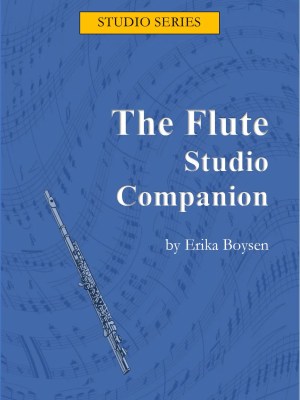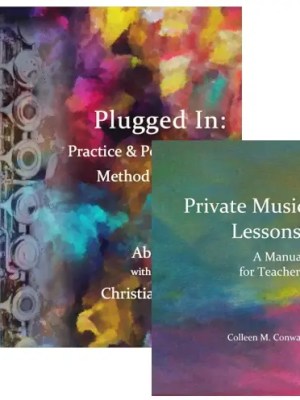Description
“Plugged In: Practice and Performance Method for Flutists” is an innovative flute method book that uniquely integrates electronic tools to enhance tonal, technical, and rhythmic stability. In the realm of music, the flute possesses a unique ability to stir emotions and captivate listeners. However, to unlock the full potential of this instrument, one must delve into a path of self-discovery and technical mastery. Divided into three distinct sections, the initial section provides foundational knowledge and skills, setting the stage for effective utilization of the electronic tools discussed in the subsequent sections. Readers of this book are likely already acquainted with the basics of flute playing, yet it is anticipated that they will find value in a comprehensive review, discover fresh insights into these crucial skills, and derive enjoyment from the new exercises.
- Preparing the Body to Play in Tone and in Tune: The initial section starts with the basics – posture, breathing, embouchure, and tone production, emphasizing the nuances of tone color and tuning. This section introduces new exercises to enhance control and expression and aims to provide fresh insights and enjoyment, refining the foundational skills necessary for advanced techniques.
- Drone Studies – Blending and Accuracy: This section harnesses the power of drone studies, crucial for musical development. It includes access to acoustic drones of the tonic and fifth in just intonation for all twelve chromatic notes, available in three timbres (oboe, flute, and clarinet) on Conway Publications’ YouTube page and other streaming platforms. These acoustic drones vary from most harmonic to hollow timbres, offering a rich palette for blending and accuracy exercises. The method trains flutists to adjust tone color, dynamics, and vibrato, while rhythmic drones sharpen timing and precision.
- Delay Studies – Precision and Artistry: The final section explores 10 original delay studies composed by Christian Glascock. Delay studies enhance rhythmic accuracy and cultivate musicianship as you adjust your playing and refine your timing by playing with an echo of yourself! Each study, inspired by nature’s power and transformative ability, captures unique aspects of the natural world – the balance of life, the passage of time, and the interplay between formidable forces and nurturing qualities. These pieces require dynamic interaction with software, synchronizing performances with past iterations. The studies are designed to enhance tone, intonation, and phrasing, deepening the theoretical understanding of music while offering fulfilling musical experiences.
Electronic Tools included in method or free to access:
- Acoustic Drone Tracks of Various Timbres
- Rhythmic Drone Tracks
- Analog Rack Delay Application (ARDelay)
- Digital Audio Workstation
“Plugged In: Practice and Performance Method for Flutists” is more than a method book; it is a journey into the heart of flute playing, blending traditional skills with innovative electronic tools. It’s an invitation to explore the expressive potential of the flute, understand the beauty of rhythmic precision, and form a deeper connection with the instrument.











Virginia Broffitt –
“This new method book is a must for flutists! The comprehensive guide places emphasis on essential skills such as tone development, flexibility, rhythm, pitch, posture, and breathing. Walsh’s approach stands out with its clear and thorough instructions, providing guidance along with practical and engaging exercises. The accompanying audio tools enhance the learning journey, especially the innovative delay studies which will challenge flutists of all levels. I wholeheartedly recommend this resource to flutists eager to elevate their playing to new heights.”
Virginia Broffitt Kunzer
Associate Professor of Flute, Auburn University
Melissa Keeling –
“This is a fantastic book for flutists who are looking to improve their rhythm and musicality through the use of delay. In my own experience, I have found that playing with effects, including delay, to be incredibly valuable in developing my musicianship. Christian Glascock’s “Delay Studies” clearly outlines how to incorporate delay in the context of ten compositions. These studies will certainly improve many areas of any flutist’s playing – and they’re a blast to perform!”
Melissa Keeling
Author, The Electric Flute: A Beginner’s Guide to Playing Flute with Effects
Rebecca Johnson –
“Dr. Abigail Walsh’s new book combines excellent discussion of flute fundamentals with inventive ways to take your practice into the future. The thorough integration of digital tools will give the next generation of flute students relevant and up to date methods to work on all aspects of their playing. I’m most excited about the structured approach to intonation and hearing and will definitely be using this method with my students!”
Rebecca Johnson
Associate Professor of Flute, Eastern Illinois University
John Wion –
“When I was a young student starting to play in ensembles it was assumed that others would adjust to the sharpness of my C# just as I would be expected to adjust to the oboe’s sharp E or flat F. It was several years later that I discovered I was actually supposed to aim at correct intonation on my instrument. Then, after a couple of years not playing ensemble music, I discovered painfully that I had been training my ear to hear as correct my flute’s intonation faults. That meant buying one of the first tuning machines and retraining my ear to hear tempered intonation. Still later, a seasoned performer, I realized that in ensembles I was only changing fingerings for the next note, followed by a quick pitch adjustment as necessary. I was not pre-hearing intervals the way a singer does.
All of which is to say just how valuable a resource Plugged In is. What a difference it would have made had I had this as a student. And how it could have changed how I taught. The concepts of tempered and just intonation are explained, and with the use of drones the ear is helped to hear and understand them. Intonation and color can be easily described as “the more you listen the more you hear”, and this book meticulously helps and directs students to accurately refine their listening. And beyond this, part three addresses rhythm, musicianship, and ensemble skill, achieved with the use of delay, an amazing concept totally new to me.”
John Wion
Former Principal Flute, New York City Opera
Emeritus Professor of Flute, The Hartt School